The Cisticolidae family of small passerine birds is a group of about 110 warblers (Cisticolas, Prinias, Apalises etc) found mainly in warmer southern regions of the Old World. They were formerly included within the Old World warbler family Sylviidae.
This family probably originated in Africa, which has the majority of species, but there are representatives of the family across tropical Asia into Australasia, and one species, the Zitting Cisticola, even breeds in Europe.
These are generally very small birds of drab brown or grey appearance found in open country such as grassland or scrub. They are often difficult to see and many species are similar in appearance, so the song is often the best identification guide. These are insectivorous birds which nest low in vegetation.
The genus Cisticola contains about 45 species. Cisticolas are widespread through the Old World's tropical and sub-tropical regions. Africa, which is home to almost all species, is the most likely ancestral home of the group. Cisticolas are usually non-migratory with most species attached to and often distinguishable by their habitats.
A variety of open habitats are occupied. These include wetlands, moist or drier grasslands, open or rocky mountain slopes, and human-modified habitats such as road verges, cultivation, weedy areas or pasture. The species preferring wetlands can be found at the edges of mangrove, or in papyrus, common reed, or typha swamps. Cisticolas are generally quite common within what remains of their preferred habitats. Because of their small size (about 10 cm) and brown plumage, they are more easily heard than seen. The similar plumage of many species can make them hard to identify, particularly in winter when they seldom emerge from their grasses. Many species are difficult to distinguish other than by their calls. Thirteen species are named for their calls, from "Singing" and "Chirping" to "Bubbling" and "Siffling".
Male cisticolas are polygamous. The female builds a discreet nest deep in the grasses, often binding living leaves into the soft fabric of felted plant down, cobweb, and grass. The average clutch is about 4 eggs, which take about 2 weeks to hatch. In summer, male cisticolas of smaller species make spectacular display flights while larger species perch in prominent places to sing lustily.
The prinias (genus Prinia) are sometimes referred to as wren-warblers. They are a little-known group of the tropical and subtropical Old World, the roughly thirty species being divided fairly equally between Africa and Asia. These are birds mainly of open habitats such as long grass or scrub, in which they are not easily seen. They are mainly resident, migration being limited to local cold weather movements. Non-breeding birds may form small flocks. Prinias have short wings but long tapering tails. They are fairly drab birds, brown or grey above (sometimes with dark streaks) and whitish below. Some species have different breeding and non-breeding plumages. The bill is a typical insectivore's, thin and slightly curved.
The apalises belong to the genus Apalis. They are found in forest, woodlands and scrub across most parts of sub-Saharan Africa. They are slender birds with long tails and have a slender bill for catching insects. They are typically brown, grey or green above and several species have brightly coloured underparts. Males and females are usually similar in appearance but the males are sometimes brighter.
Africa Wild Bird Book
Family Cisticolidae (Cisticolas and Allies) Index
Family Cisticolidae (Cisticolas and allies)
Cisticola erythrops Red-faced Cisticola 674
Cisticola cantans Singing Cisticola 673
Cisticola aberrans Lazy Cisticola 679
Cisticola chiniana Rattling Cisticola 672
Cisticola rufilatus Tinkling Cisticola 671
Cisticola subruficapilla Grey-backed Cisticola 669
Cisticola lais Wailing Cisticola 670
Cisticola galactotes Rufous-winged Cisticola 675
Cisticola luapula Luapula Cisticola
Cisticola pipiens Chirping Cisticola 676
Cisticola tinniens Levaillant's Cisticola 677
Cisticola natalensis Croaking Cisticola 678
Cisticola brachypterus Short-winged Cisticola 680
Cisticola fulvicapilla Neddicky 681
Cisticola juncidis Zitting Cisticola 664
Cisticola aridulus Desert Cisticola 665
Cisticola textrix Cloud Cisticola 666
Cisticola cinnamomeus Pale-crowned Cisticola 668
Cisticola ayresii Wing-snapping Cisticola 667
Prinia subflava Tawny-flanked Prinia 683
Prinia flavicans Black-chested Prinia 685
Prinia maculosa Karoo Prinia 686
Prinia hypoxantha Drakensberg Prinia 686.1
Phragmacia substriata Namaqua Warbler 687
Oreophilais robertsi Roberts's Warbler 684
Heliolais erythropterus Red-winged Warbler 682
Apalis thoracica Bar-throated Apalis 645
Apalis ruddi Rudd's Apalis 649
Apalis flavida Yellow-breasted Apalis 648
Apalis melanocephala Black-headed Apalis 647
Apalis chirindensis Chirinda Apalis 646
Malcorus pectoralis Rufous-eared Warbler 688
Camaroptera brachyura Green-backed Camaroptera 657a
Camaroptera brevicaudata Grey-backed Camaroptera 657b
Calamonastes stierlingi Stierling's Wren-Warbler 659
Calamonastes fasciolatus Barred Wren-Warbler 658
Euryptila subcinnamomea Cinnamon-breasted Warbler 660
Eremomela icteropygialis Yellow-bellied Eremomela 653
Eremomela scotops Green-capped Eremomela 655
Eremomela gregalis Karoo Eremomela 654
[Eremomela usticollis Burnt-necked Eremomela 656
Cisticola erythrops Red-faced Cisticola 674
Cisticola cantans Singing Cisticola 673
Cisticola aberrans Lazy Cisticola 679
Cisticola chiniana Rattling Cisticola 672
Cisticola rufilatus Tinkling Cisticola 671
Cisticola subruficapilla Grey-backed Cisticola 669
Cisticola lais Wailing Cisticola 670
Cisticola galactotes Rufous-winged Cisticola 675
Cisticola luapula Luapula Cisticola
Cisticola pipiens Chirping Cisticola 676
Cisticola tinniens Levaillant's Cisticola 677
Cisticola natalensis Croaking Cisticola 678
Cisticola brachypterus Short-winged Cisticola 680
Cisticola fulvicapilla Neddicky 681
Cisticola juncidis Zitting Cisticola 664
Cisticola aridulus Desert Cisticola 665
Cisticola textrix Cloud Cisticola 666
Cisticola cinnamomeus Pale-crowned Cisticola 668
Cisticola ayresii Wing-snapping Cisticola 667
Prinia subflava Tawny-flanked Prinia 683
Prinia flavicans Black-chested Prinia 685
Prinia maculosa Karoo Prinia 686
Prinia hypoxantha Drakensberg Prinia 686.1
Phragmacia substriata Namaqua Warbler 687
Oreophilais robertsi Roberts's Warbler 684
Heliolais erythropterus Red-winged Warbler 682
Apalis thoracica Bar-throated Apalis 645
Apalis ruddi Rudd's Apalis 649
Apalis flavida Yellow-breasted Apalis 648
Apalis melanocephala Black-headed Apalis 647
Apalis chirindensis Chirinda Apalis 646
Malcorus pectoralis Rufous-eared Warbler 688
Camaroptera brachyura Green-backed Camaroptera 657a
Camaroptera brevicaudata Grey-backed Camaroptera 657b
Calamonastes stierlingi Stierling's Wren-Warbler 659
Calamonastes fasciolatus Barred Wren-Warbler 658
Euryptila subcinnamomea Cinnamon-breasted Warbler 660
Eremomela icteropygialis Yellow-bellied Eremomela 653
Eremomela scotops Green-capped Eremomela 655
Eremomela gregalis Karoo Eremomela 654
[Eremomela usticollis Burnt-necked Eremomela 656
- Flutterby
- Posts: 44029
- Joined: Sat May 19, 2012 12:28 pm
- Country: South Africa
- Location: Gauteng, South Africa
- Contact:
Red-faced Cisticola
674. Red-faced Cisticola Cisticola chiniana (Rooiwangtinktinkie)
Order: Passeriformes. Family: Cisticolidae
Description
13-14cm. The Red-faced Cisticola differs from other reed-dwelling cisticolas in having a uniformly coloured (not streaked) back. The face, sides of the breast and flanks are washed with rufous in non-breeding plumage. Sexes are alike.
Ad breeding: Face pale rufous to tawny red, with indistinct pale supercilium. Forecrown rusty buff, grading into pale olive-grey on remainder of upper parts, incl wings. Tail olive-grey, with dark brown subterminal band and greyish-brown tip. Underwing coverts rufous-buff; axillaries olivaceous-buff. Chin, throat and centre of belly plain silky white, remainder of underparts suffused with rich buff, sides washed smoky grey. Upper mandible blackish, lower mandible paler, pinkish white at base. Eyes pale brown. Legs and feet pinkish brown.
Ad non-breeding: As breeding ad, but crown and nape browner, upper parts more olivaceous; tail tip white. Underparts rich rufous-buff.
Juvenile: Resembles adult but is duller.
Similar species: It differs from the Singing Cisticola in lacking rufous edges to its primaries.
Distribution
It is found in Angola, Benin, Botswana, Burkina Faso, Burundi, Cameroon, Central African Republic, Republic of the Congo, Democratic Republic of the Congo, Ivory Coast, Ethiopia, Gabon, Gambia, Ghana, Guinea, Kenya, Liberia, Malawi, Mali, Mauritania, Mozambique, Namibia, Nigeria, Rwanda, Senegal, Sierra Leone, South Africa, Sudan, Swaziland, Tanzania, Togo, Uganda, Zambia, and Zimbabwe.
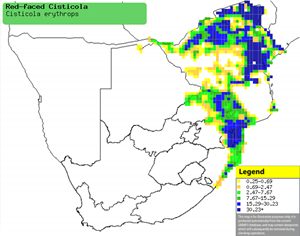
Habitat
Reedbeds and rank vegetation bordering streams.
Diet
It eats a variety of insects, doing most of its foraging low down in the undergrowth.
Breeding
The nest is oval-shaped with a side entrance, built of leaves and dry grass secured with spider web, with an outer shell of living leaves. A soft plant down lining is added by the female during incubation. It is typically incorporated into the foliage of a herb, shrub, forb or small tree, usually less than half a metre above ground. Egg-laying season is from October-March, peaking from about December-February. It lays 2-4 eggs, which are incubated mainly by the female for about 12-16 days. At first the chicks are brooded by the female, while the male regularly brings her and her young food. They usually stay in the nest for about 14-16 days.
Call
A series of piercing whistles, 'weee, cheee, cheee, cheer, cheer', rising and falling in scale, uttered from a perch.
Status
Common resident.
Order: Passeriformes. Family: Cisticolidae
Description
13-14cm. The Red-faced Cisticola differs from other reed-dwelling cisticolas in having a uniformly coloured (not streaked) back. The face, sides of the breast and flanks are washed with rufous in non-breeding plumage. Sexes are alike.
Ad breeding: Face pale rufous to tawny red, with indistinct pale supercilium. Forecrown rusty buff, grading into pale olive-grey on remainder of upper parts, incl wings. Tail olive-grey, with dark brown subterminal band and greyish-brown tip. Underwing coverts rufous-buff; axillaries olivaceous-buff. Chin, throat and centre of belly plain silky white, remainder of underparts suffused with rich buff, sides washed smoky grey. Upper mandible blackish, lower mandible paler, pinkish white at base. Eyes pale brown. Legs and feet pinkish brown.
Ad non-breeding: As breeding ad, but crown and nape browner, upper parts more olivaceous; tail tip white. Underparts rich rufous-buff.
Juvenile: Resembles adult but is duller.
Similar species: It differs from the Singing Cisticola in lacking rufous edges to its primaries.
Distribution
It is found in Angola, Benin, Botswana, Burkina Faso, Burundi, Cameroon, Central African Republic, Republic of the Congo, Democratic Republic of the Congo, Ivory Coast, Ethiopia, Gabon, Gambia, Ghana, Guinea, Kenya, Liberia, Malawi, Mali, Mauritania, Mozambique, Namibia, Nigeria, Rwanda, Senegal, Sierra Leone, South Africa, Sudan, Swaziland, Tanzania, Togo, Uganda, Zambia, and Zimbabwe.

Habitat
Reedbeds and rank vegetation bordering streams.
Diet
It eats a variety of insects, doing most of its foraging low down in the undergrowth.
Breeding
The nest is oval-shaped with a side entrance, built of leaves and dry grass secured with spider web, with an outer shell of living leaves. A soft plant down lining is added by the female during incubation. It is typically incorporated into the foliage of a herb, shrub, forb or small tree, usually less than half a metre above ground. Egg-laying season is from October-March, peaking from about December-February. It lays 2-4 eggs, which are incubated mainly by the female for about 12-16 days. At first the chicks are brooded by the female, while the male regularly brings her and her young food. They usually stay in the nest for about 14-16 days.
Call
A series of piercing whistles, 'weee, cheee, cheee, cheer, cheer', rising and falling in scale, uttered from a perch.
Status
Common resident.
- Flutterby
- Posts: 44029
- Joined: Sat May 19, 2012 12:28 pm
- Country: South Africa
- Location: Gauteng, South Africa
- Contact:
Red-faced Cisticola Photos
674. Red-faced Cisticola Cisticola chiniana
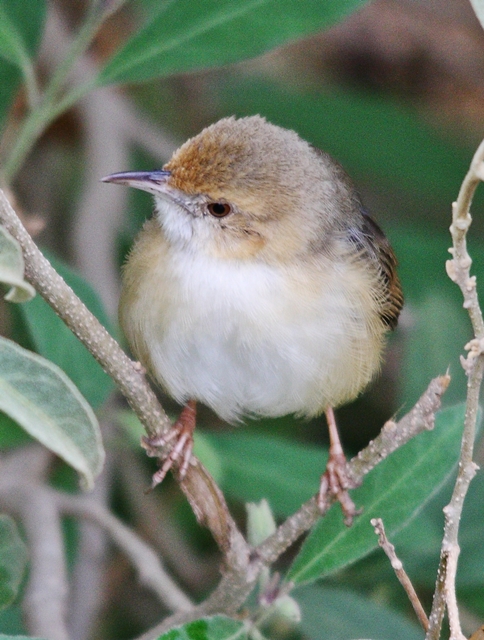
Lower Sabie, Kruger Park
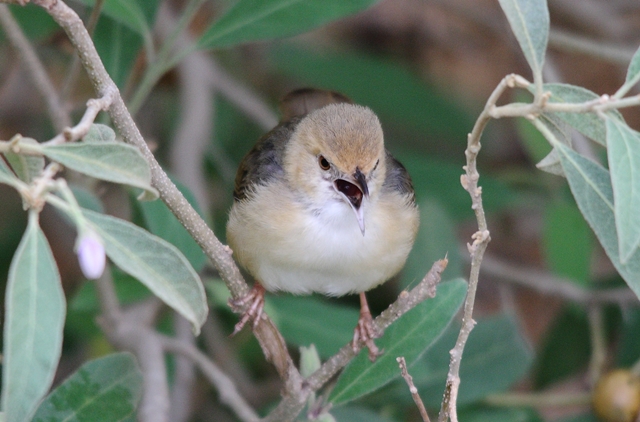
Lower Sabie, Kruger Park
Links:
Newman's Birds of Southern Africa
Sabap2
Species Text Sabap1

Lower Sabie, Kruger Park

Lower Sabie, Kruger Park
Links:
Newman's Birds of Southern Africa
Sabap2
Species Text Sabap1
- Flutterby
- Posts: 44029
- Joined: Sat May 19, 2012 12:28 pm
- Country: South Africa
- Location: Gauteng, South Africa
- Contact:
Rattling Cisticola
672. Rattling Cisticola Cisticola chiniana (Bosveldtintinkie)
Order: Passeriformes. Family: Cisticolidae
Description
11-14 cm. The noisiest and most obvious and abundant cisticola of the bushveld areas. Greyish-brown upperparts. Plain rufous crown: forehead, ear, nape and ear coverts buffy brown. Greyish-brown back (more rufous in winter), streaked dusky. Underparts creamy white; tail dusky brown (rufous in Tinkling Cisticola), tipped white, subterminal band black. Sexes are alike.
Juvenile: Duller than adult; no yellow below.
Similar species: Easily confused with Tinkling Cisticola but has much less red on the head, and the rufous tail is not as bright.
Distribution
From Ethiopia south to through the DRC, Tanzania, Angola and Zambia to southern Africa.
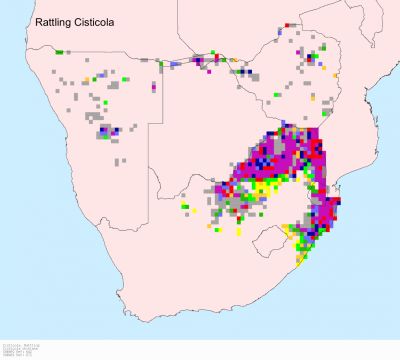
Habitat
Woodland, Acacia savanna and scrub, gardens and patches of bush in open grassland.
Diet
It mainly eats invertebrates, often foraging in the undergrowth and on the ground, occasionally plucking termite alates from the air.
Breeding
The nest is an oval or ball shape with a side entrance, built of dry grass secured with spider web. It is typically attached with spider web to a grass tuft, shrub, Acacia sapling or a fallen branch's foliage, usually up to 1.2 m high. Egg-laying season is from October-April, peaking from about November-January. It lays 2-5 eggs, which are incubated solely by the female for roughly 13-14 days. The chicks stay in the nest for about 13-15 days.
Call
A series of high-pitched notes cher, cher, cher, tsee, tsee, tsee, given from the top of a bush. Listen to Bird Call.
Status
Common resident.
Order: Passeriformes. Family: Cisticolidae
Description
11-14 cm. The noisiest and most obvious and abundant cisticola of the bushveld areas. Greyish-brown upperparts. Plain rufous crown: forehead, ear, nape and ear coverts buffy brown. Greyish-brown back (more rufous in winter), streaked dusky. Underparts creamy white; tail dusky brown (rufous in Tinkling Cisticola), tipped white, subterminal band black. Sexes are alike.
Juvenile: Duller than adult; no yellow below.
Similar species: Easily confused with Tinkling Cisticola but has much less red on the head, and the rufous tail is not as bright.
Distribution
From Ethiopia south to through the DRC, Tanzania, Angola and Zambia to southern Africa.

Habitat
Woodland, Acacia savanna and scrub, gardens and patches of bush in open grassland.
Diet
It mainly eats invertebrates, often foraging in the undergrowth and on the ground, occasionally plucking termite alates from the air.
Breeding
The nest is an oval or ball shape with a side entrance, built of dry grass secured with spider web. It is typically attached with spider web to a grass tuft, shrub, Acacia sapling or a fallen branch's foliage, usually up to 1.2 m high. Egg-laying season is from October-April, peaking from about November-January. It lays 2-5 eggs, which are incubated solely by the female for roughly 13-14 days. The chicks stay in the nest for about 13-15 days.
Call
A series of high-pitched notes cher, cher, cher, tsee, tsee, tsee, given from the top of a bush. Listen to Bird Call.
Status
Common resident.
- Flutterby
- Posts: 44029
- Joined: Sat May 19, 2012 12:28 pm
- Country: South Africa
- Location: Gauteng, South Africa
- Contact:
Rattling Cisticola Photos
672. Rattling Cisticola Cisticola chiniana
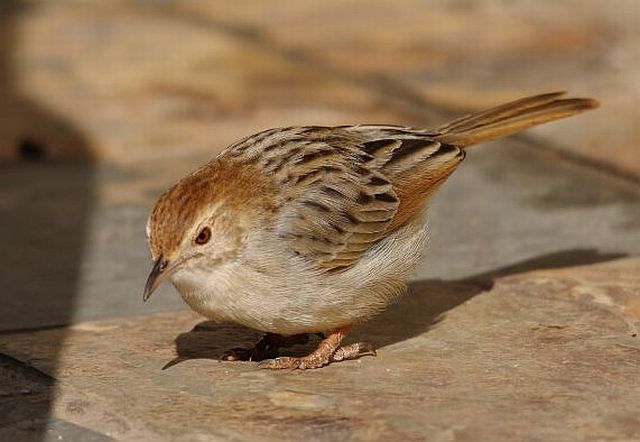 © Flutterby
© Flutterby
Pilanesberg
 © Dewi
© Dewi
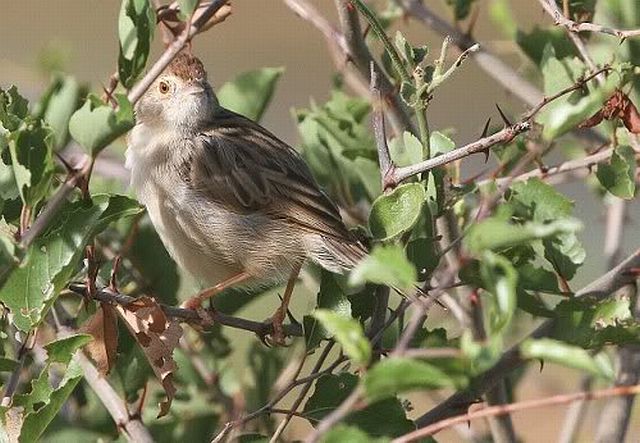 © nan
© nan
 © Toko
© Toko
iMfolozi GR, KwaZulu-Natal
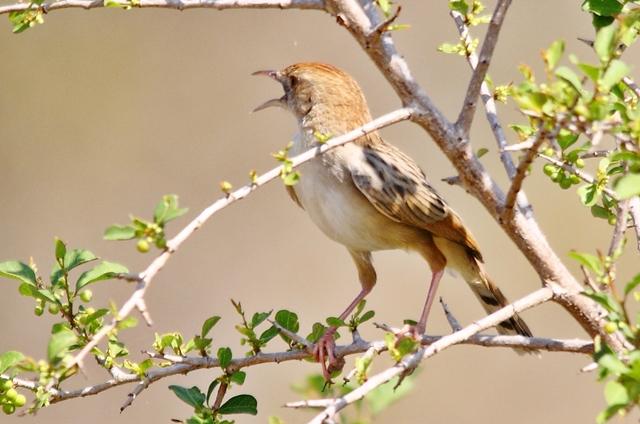 © Flutterby
© Flutterby
Kruger National Park
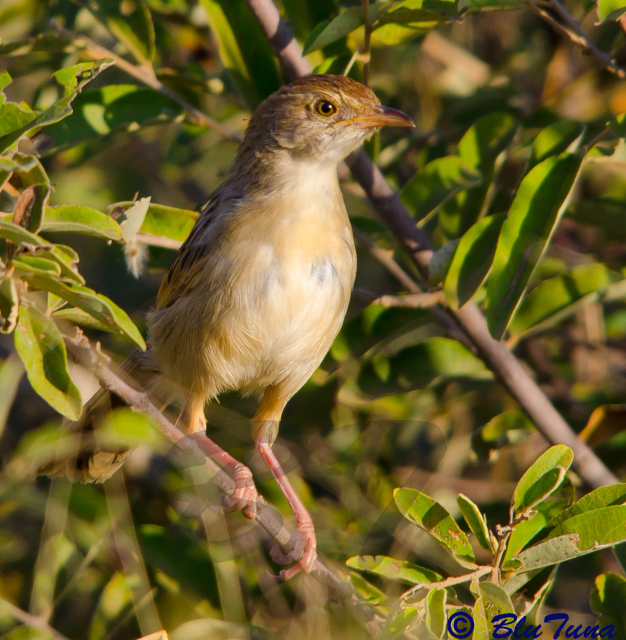 © BluTuna
© BluTuna
Kruger National Park
Links:
Sabap2
 © Flutterby
© FlutterbyPilanesberg
 © Dewi
© Dewi © nan
© nan © Toko
© TokoiMfolozi GR, KwaZulu-Natal
 © Flutterby
© FlutterbyKruger National Park
 © BluTuna
© BluTunaKruger National Park
Links:
Sabap2
Grey-backed Cisticola
669. Grey-backed Cisticola Cisticola subruficapilla (Grysrugtinktinkie)
Order: Passeriformes. Family: Cisticolidae
Description
13-14 cm. A medium-small, streak-backed cisticola with fairly long graduated tail. Rufous panel in the folded wing. Crown dullish dark rufous merging with grey of back, faintly streaked blackish (streaking not usually visible in field); eyebrow indistinct; back grey, finely streaked black; rest of underparts dull whitish (clearly spotted darker in SW Cape birds; spots vestigial in other populations); tail longish, dusky, tipped pale brown, subterminal band black. Birds in drier areas paler and less distinctly streaked than those further East. Iris light brown. Grey short straight bill; culmen blackish brown; legs and feet pinkish.
Southern form (southern Namibia and South Africa): Grey back streaked black. White underparts.
Northern form: Brown back streaked black. Buff underparts.
Juvenile: Similar to adult; only faintly washed yellowish below (much brighter yellow in immature Wailing Cisticola).
Similar species: The northern form closely resembles Wailing Cisticola, differing in having cold greyish buff underparts (not buff). Levaillant's Cisticola has black-and-brown (not grey-and-brown) streaked back, contrasting strongly with brighter chestnut crown and tail.
Taxonomy
Cisticola subruficapilla has six subspecies:
C. s. newtoni: South-western Angola and north-western Namibia
C. s. windhoekensis: Central Namibia
C. s. karasensis: North-central South Africa
C. s. namaqua: Southern Namibia and north-western South Africa
C. s. subruficapilla: Southern Western Cape Province
C. s. jamesi: South-central South Africa
Distribution
Near-endemic to southern Africa, occurring from South Africa through Namibia to extreme south-western Angola.
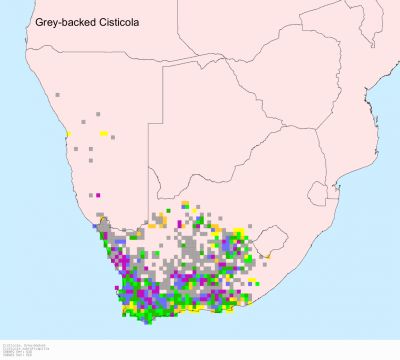
Habitat
It generally prefers lowland fynbos, renosterveld and Karoo scrub, open strandveld, dune scrub, occasionally moving into thickets of alien plants, such as Jackson willow (Acacia saligna) and Rooikrans (Acacia cyclops) and arid hillsides - typically in drier habitats than the closely related Wailing Cisticola.
Diet
It mainly eats insects (termites, beetles, beetle larvae, caterpillars and small grasshoppers), gleaning them from the undergrowth and bare soil.
Breeding
Usually monogamous, but male plays little part in chick-rearing and may be serially polygynous. The nest is a ball shape with a side entrance, built of grass and bark shreds from Lammerlat (Asclepias buchenaviana), or alternatively using hairy flower stems with the attached seeds of Galium tomentosum (Old-man's beard creeper). During incubation a lining of soft plant down is added, often extracted from Karoo rosemaries (Eriocephalus). It is typically placed close to the ground in a shrub or grass tuft, the leaves of which are often incorporated into the nest. Egg-laying season is from July-January, peaking from about August-October. The eggs are whitish to pale blue, spotted with red-brown, brown and purplish. The female lays 2-5 eggs, which are incubate for about 12-14 days. The chicks stay in the nest for about 11-16 days.
Call
High-pitched prrrreeee tee tee tee tee.
Status
Common resident; may be conspecific with Wailing Cisticola.
Order: Passeriformes. Family: Cisticolidae
Description
13-14 cm. A medium-small, streak-backed cisticola with fairly long graduated tail. Rufous panel in the folded wing. Crown dullish dark rufous merging with grey of back, faintly streaked blackish (streaking not usually visible in field); eyebrow indistinct; back grey, finely streaked black; rest of underparts dull whitish (clearly spotted darker in SW Cape birds; spots vestigial in other populations); tail longish, dusky, tipped pale brown, subterminal band black. Birds in drier areas paler and less distinctly streaked than those further East. Iris light brown. Grey short straight bill; culmen blackish brown; legs and feet pinkish.
Southern form (southern Namibia and South Africa): Grey back streaked black. White underparts.
Northern form: Brown back streaked black. Buff underparts.
Juvenile: Similar to adult; only faintly washed yellowish below (much brighter yellow in immature Wailing Cisticola).
Similar species: The northern form closely resembles Wailing Cisticola, differing in having cold greyish buff underparts (not buff). Levaillant's Cisticola has black-and-brown (not grey-and-brown) streaked back, contrasting strongly with brighter chestnut crown and tail.
Taxonomy
Cisticola subruficapilla has six subspecies:
C. s. newtoni: South-western Angola and north-western Namibia
C. s. windhoekensis: Central Namibia
C. s. karasensis: North-central South Africa
C. s. namaqua: Southern Namibia and north-western South Africa
C. s. subruficapilla: Southern Western Cape Province
C. s. jamesi: South-central South Africa
Distribution
Near-endemic to southern Africa, occurring from South Africa through Namibia to extreme south-western Angola.

Habitat
It generally prefers lowland fynbos, renosterveld and Karoo scrub, open strandveld, dune scrub, occasionally moving into thickets of alien plants, such as Jackson willow (Acacia saligna) and Rooikrans (Acacia cyclops) and arid hillsides - typically in drier habitats than the closely related Wailing Cisticola.
Diet
It mainly eats insects (termites, beetles, beetle larvae, caterpillars and small grasshoppers), gleaning them from the undergrowth and bare soil.
Breeding
Usually monogamous, but male plays little part in chick-rearing and may be serially polygynous. The nest is a ball shape with a side entrance, built of grass and bark shreds from Lammerlat (Asclepias buchenaviana), or alternatively using hairy flower stems with the attached seeds of Galium tomentosum (Old-man's beard creeper). During incubation a lining of soft plant down is added, often extracted from Karoo rosemaries (Eriocephalus). It is typically placed close to the ground in a shrub or grass tuft, the leaves of which are often incorporated into the nest. Egg-laying season is from July-January, peaking from about August-October. The eggs are whitish to pale blue, spotted with red-brown, brown and purplish. The female lays 2-5 eggs, which are incubate for about 12-14 days. The chicks stay in the nest for about 11-16 days.
Call
High-pitched prrrreeee tee tee tee tee.
Status
Common resident; may be conspecific with Wailing Cisticola.
Grey-backed Cisticola Photos
669. Grey-backed Cisticola Cisticola subruficapilla
 © Tina
© Tina
West Coast National Park, Western Cape
Links:
Species text Sabap1: http://sabap2.adu.org.za/docs/sabap1/669.pdf
Sabap2
Newman's
Sasol Birds of Southern Africa
 © Tina
© TinaWest Coast National Park, Western Cape
Links:
Species text Sabap1: http://sabap2.adu.org.za/docs/sabap1/669.pdf
Sabap2
Newman's
Sasol Birds of Southern Africa
- nan
- Posts: 26476
- Joined: Thu May 31, 2012 9:41 pm
- Country: Switzerland
- Location: Central Europe
- Contact:
Levaillant's Cisticola
677. Levaillant's Cisticola Cisticola tinniens (Vleitinktinkie)
Order: Passeriformes. Family: Cisticolidae
Description
Length 12-15 cm. This is one of the dark-backed cisticolas, dull-coloured with a longish tail and a reddish cap. The short straight bill is blackish-brown with a pinkish base, and the feet and legs are pinkish-brown. The eye is light brown.
Breeding adult: Grey upperparts heavily streaked with black. Rufous panel in the folded wing. Buffish-white supercilium, face and underparts. Red cap. Russet brown tail.
Non-breeding adults are browner-backed.
Juvenile birds have yellower underparts.
Could be confused with Rufus-winged Cisticola but is normally distinguished by its reddish (not grey) tail; at close range it can be seen that the black feathers of its back are edged with brown (not grey). The song and call of this species differ from those of Rufous-winged Cisticola. Ranges overlap marginally in southern KwaZulu-Natal.
Distribution
It has populations scattered across Africa south of the Sahel, from Kenya to Zambia, Angola and southern Africa. Levaillant’s Cisticola is widespread in South Africa, Lesotho and western Swaziland, common throughout parts of southern Africa with a relatively temperate climate. In South Africa it is most abundant in the western Cape Province, Free State, southern Transvaal and high-lying areas of KwaZulu-Natal.
Habitat
Reedbeds, sedges and long grass adjacent to rivers and dam, Karoo grassland. Usually associated with marsh and wetland habitat. Levaillant's Cisticola is the common pond and streamside cisticola frequenting waterside sedges, usually within 100 m from water.
Diet
It mainly eats small insects, doing most of its foraging low down in the undergrowth.
Breeding
The nest is an oval or ball shape with a side entrance, built of dry grass secured with spider web and typically placed near the ground or water, often in a grass tuft or bush overhanging a stream. A thick lining of plant down is added to the interior by the female during incubation. Egg-laying season is from September-May, peaking from November-March. It lays 2-5 eggs, which are incubated for about 11-14 days. The chicks leave the nest after about 14-15 days.
Call
The calls include a musical chrip-trrrup-trreee, a wailing tee tee tee and harsh alarm notes. Listen to Bird Call.
Status
Common resident.
Order: Passeriformes. Family: Cisticolidae
Description
Length 12-15 cm. This is one of the dark-backed cisticolas, dull-coloured with a longish tail and a reddish cap. The short straight bill is blackish-brown with a pinkish base, and the feet and legs are pinkish-brown. The eye is light brown.
Breeding adult: Grey upperparts heavily streaked with black. Rufous panel in the folded wing. Buffish-white supercilium, face and underparts. Red cap. Russet brown tail.
Non-breeding adults are browner-backed.
Juvenile birds have yellower underparts.
Could be confused with Rufus-winged Cisticola but is normally distinguished by its reddish (not grey) tail; at close range it can be seen that the black feathers of its back are edged with brown (not grey). The song and call of this species differ from those of Rufous-winged Cisticola. Ranges overlap marginally in southern KwaZulu-Natal.
Distribution
It has populations scattered across Africa south of the Sahel, from Kenya to Zambia, Angola and southern Africa. Levaillant’s Cisticola is widespread in South Africa, Lesotho and western Swaziland, common throughout parts of southern Africa with a relatively temperate climate. In South Africa it is most abundant in the western Cape Province, Free State, southern Transvaal and high-lying areas of KwaZulu-Natal.
Habitat
Reedbeds, sedges and long grass adjacent to rivers and dam, Karoo grassland. Usually associated with marsh and wetland habitat. Levaillant's Cisticola is the common pond and streamside cisticola frequenting waterside sedges, usually within 100 m from water.
Diet
It mainly eats small insects, doing most of its foraging low down in the undergrowth.
Breeding
The nest is an oval or ball shape with a side entrance, built of dry grass secured with spider web and typically placed near the ground or water, often in a grass tuft or bush overhanging a stream. A thick lining of plant down is added to the interior by the female during incubation. Egg-laying season is from September-May, peaking from November-March. It lays 2-5 eggs, which are incubated for about 11-14 days. The chicks leave the nest after about 14-15 days.
Call
The calls include a musical chrip-trrrup-trreee, a wailing tee tee tee and harsh alarm notes. Listen to Bird Call.
Status
Common resident.
Kgalagadi lover… for ever
https://safrounet.piwigo.com/
https://safrounet.piwigo.com/
- nan
- Posts: 26476
- Joined: Thu May 31, 2012 9:41 pm
- Country: Switzerland
- Location: Central Europe
- Contact:
Levaillant's Cisticola Photos
677. Levaillant's Cisticola Cisticola tinniens
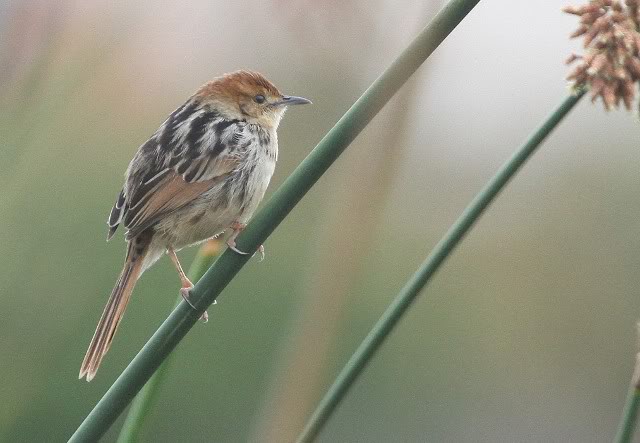

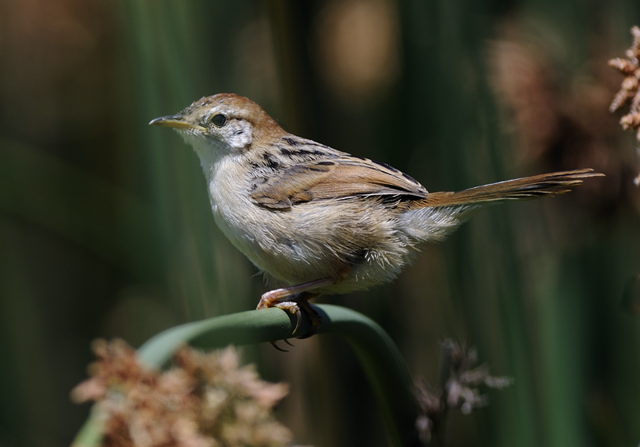 © Dewi
© Dewi
 © steamtrainfan
© steamtrainfan
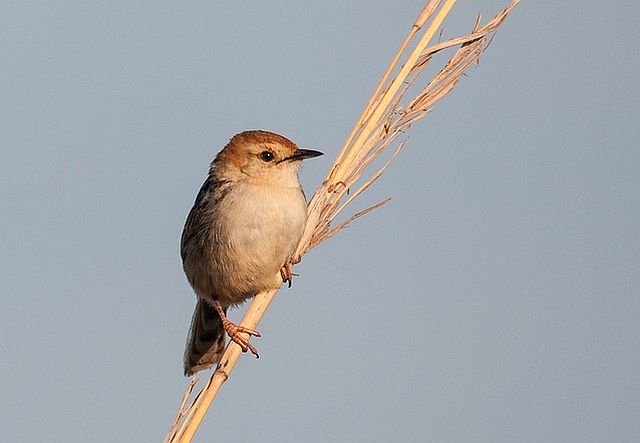 © steamtrainfan
© steamtrainfan
Rietvlei, Gauteng
 © steamtrainfan
© steamtrainfan
Rietvlei, Gauteng
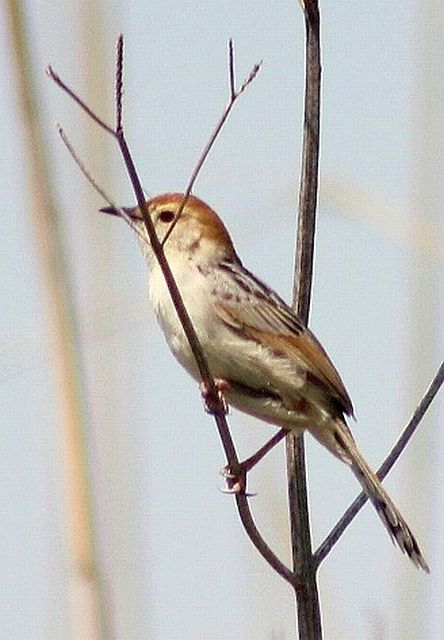 © Amoli
© Amoli
Rietvlei, Gauteng
Links:
http://sabap2.adu.org.za/docs/sabap1/677.pdf
http://sabap2.adu.org.za/spp_summary.ph ... §ion=3


 © Dewi
© Dewi © steamtrainfan
© steamtrainfan © steamtrainfan
© steamtrainfanRietvlei, Gauteng
 © steamtrainfan
© steamtrainfanRietvlei, Gauteng
 © Amoli
© AmoliRietvlei, Gauteng
Links:
http://sabap2.adu.org.za/docs/sabap1/677.pdf
http://sabap2.adu.org.za/spp_summary.ph ... §ion=3
Kgalagadi lover… for ever
https://safrounet.piwigo.com/
https://safrounet.piwigo.com/


